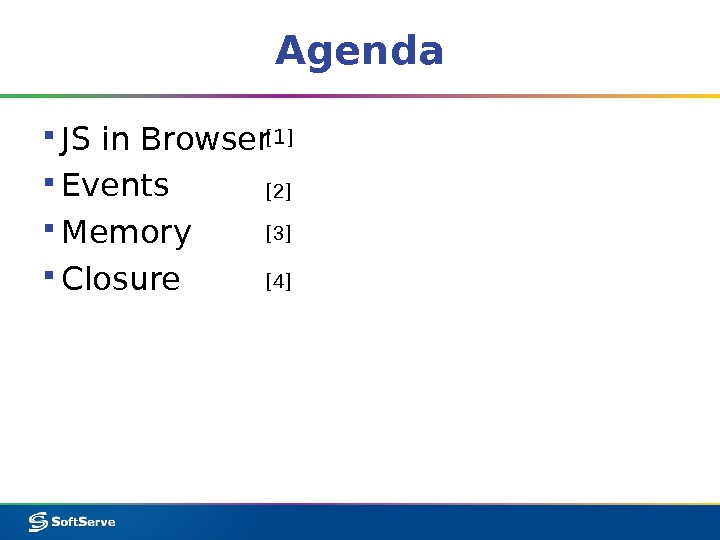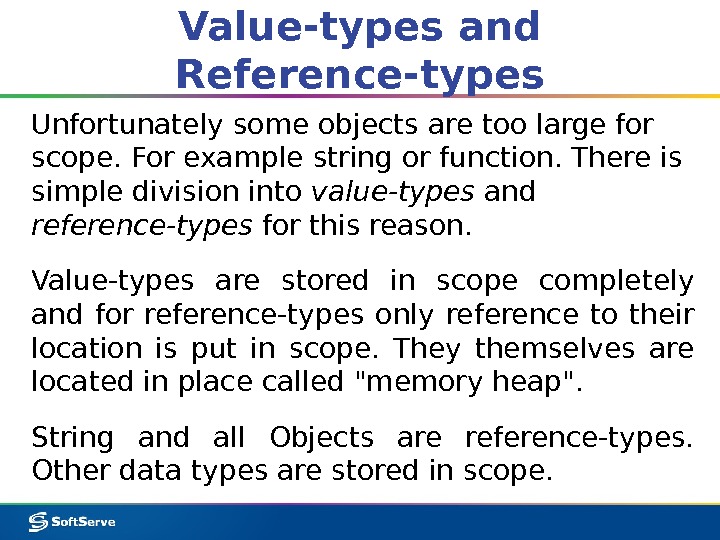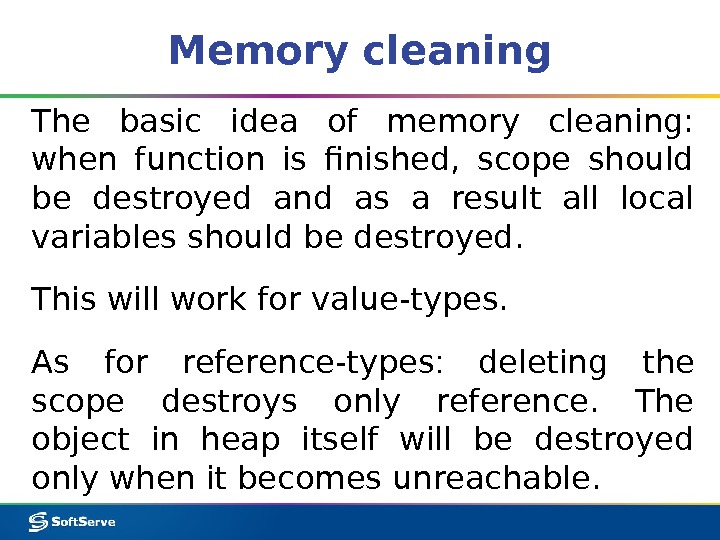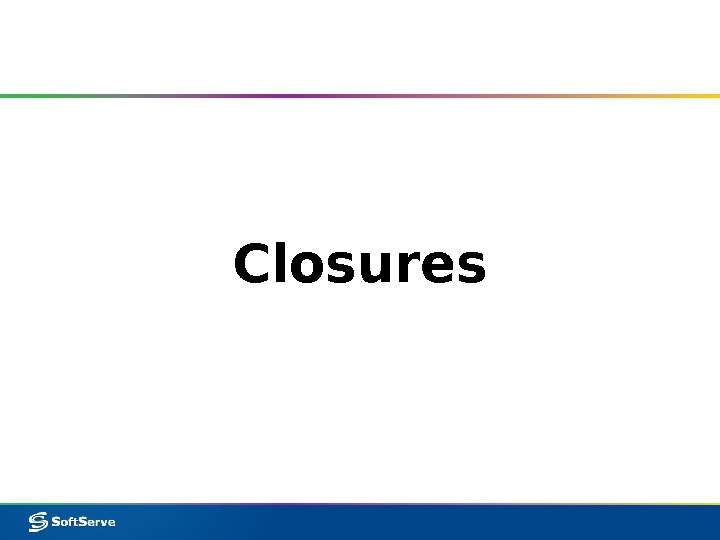Module 5: Java. Script in Browser D.




























- Размер: 1 Mегабайта
- Количество слайдов: 28
Описание презентации Module 5: Java. Script in Browser D. по слайдам
 Module 5: Java. Script in Browser D. Petin 07/
Module 5: Java. Script in Browser D. Petin 07/
![Agenda ▪ JS in Browser ▪ Events ▪ Memory ▪ Closure [1] [ 2 ] [ Agenda ▪ JS in Browser ▪ Events ▪ Memory ▪ Closure [1] [ 2 ] [](/docs//module_5_js_in_browser_images/module_5_js_in_browser_1.jpg) Agenda ▪ JS in Browser ▪ Events ▪ Memory ▪ Closure [1] [ 2 ] [ 3 ] [ 4 ]
Agenda ▪ JS in Browser ▪ Events ▪ Memory ▪ Closure [1] [ 2 ] [ 3 ] [ 4 ]
 Java. Script in Browser
Java. Script in Browser
 Java. Script in Browser BOM window DOM
Java. Script in Browser BOM window DOM
 Events
Events
 Description How Java. Script communicates with the world? In outline this mechanism works by next scenario: user does something and this action is an event for browser. Java. Script observes pages in the browser. And if event has occurred, script will be activated. [1]
Description How Java. Script communicates with the world? In outline this mechanism works by next scenario: user does something and this action is an event for browser. Java. Script observes pages in the browser. And if event has occurred, script will be activated. [1]
 Event handling But Java. Script doesn’t observe events by default. You should specify to your code what events are interesting for it. There are 3 basic ways to subscribe to an event: — inline in HTML — using of onevent attribute — using special methods First and second ways are deprecated for present days. Let’s take a look at event handling in more details. [1] [ 2 ]
Event handling But Java. Script doesn’t observe events by default. You should specify to your code what events are interesting for it. There are 3 basic ways to subscribe to an event: — inline in HTML — using of onevent attribute — using special methods First and second ways are deprecated for present days. Let’s take a look at event handling in more details. [1] [ 2 ]
 Inline handling Imagine that we have some HTML-element, for example
Inline handling Imagine that we have some HTML-element, for example
 Using of onevent attribute btn. onclick = action; The next way doesn’t touch HTML. For adding event handler you need to find an object that is a Java. Script model of HTML-element. For example, your button has id btn :
Using of onevent attribute btn. onclick = action; The next way doesn’t touch HTML. For adding event handler you need to find an object that is a Java. Script model of HTML-element. For example, your button has id btn :
 Proper ways Previous way makes sense, but has some limitations. For example you can not use more than one handler for one event, because you set a function on onevent attribute directly. btn. add. Event. Listener( “click” , action , false); But this method doesn’t work in IE. For IE you should use: Next method helps solve this and some other problems: btn. attach. Event( “onclick” , action ); [1] [2]
Proper ways Previous way makes sense, but has some limitations. For example you can not use more than one handler for one event, because you set a function on onevent attribute directly. btn. add. Event. Listener( “click” , action , false); But this method doesn’t work in IE. For IE you should use: Next method helps solve this and some other problems: btn. attach. Event( “onclick” , action ); [1] [2]
 Proper ways btn. remove. Event. Listener( “click” , action ); In IE: Also, you can unsubscribe from any event. In W 3 C: btn. detach. Event( “onclick” , action ); Interesting note Why we refer to W 3 C if Java. Script syntax is specified by ECMA? Because ECMA specifies only cross-platform part of language and does not describes any API. The browser API is determined by W 3 C standards. It applies to events, DOM, storages, etc. [1]
Proper ways btn. remove. Event. Listener( “click” , action ); In IE: Also, you can unsubscribe from any event. In W 3 C: btn. detach. Event( “onclick” , action ); Interesting note Why we refer to W 3 C if Java. Script syntax is specified by ECMA? Because ECMA specifies only cross-platform part of language and does not describes any API. The browser API is determined by W 3 C standards. It applies to events, DOM, storages, etc. [1]
 Bubbling and Capturing The third parameter of add. Event. Listener is a phase of event processing. There are 2 phases: — bubbling (if parameter is ‘false’ ) — capturing (if parameter is ‘true’ ). W 3 C browsers supports both phases whereas in IE only bubbling is supported. For example: There are three nested elements like , and (
Bubbling and Capturing The third parameter of add. Event. Listener is a phase of event processing. There are 2 phases: — bubbling (if parameter is ‘false’ ) — capturing (if parameter is ‘true’ ). W 3 C browsers supports both phases whereas in IE only bubbling is supported. For example: There are three nested elements like , and (
![Bubbling and Capturing Bubbling Capturingred green blue / /green /red [1] [2] [3] Bubbling and Capturing Bubbling Capturingred green blue / /green /red [1] [2] [3]](/docs//module_5_js_in_browser_images/module_5_js_in_browser_12.jpg) Bubbling and Capturing Bubbling Capturing [1] [2] [3]
Bubbling and Capturing Bubbling Capturing [1] [2] [3]
 Event object For every event in the browser instance of Event object will be created. You can take it if you need. In W 3 C browsers this object will be passed as a first parameter of event handler: btn. add. Event. Listener( “click” , action, false); Where action was defined as: function action (e) { . . . }[1]
Event object For every event in the browser instance of Event object will be created. You can take it if you need. In W 3 C browsers this object will be passed as a first parameter of event handler: btn. add. Event. Listener( “click” , action, false); Where action was defined as: function action (e) { . . . }[1]
 Event object is supported in IE, too, but it’s located in object window and its name is event : var e = window. event; You have a possibility to use a cross-browser solution. : function action (e) { e = e || window. event ; . . . } [1] [2]
Event object is supported in IE, too, but it’s located in object window and its name is event : var e = window. event; You have a possibility to use a cross-browser solution. : function action (e) { e = e || window. event ; . . . } [1] [2]
 Control of Default behavior Sometimes a default scenario of event processing includes some additional behavior: bubbling and capturing or displaying context menu. If you don’t need a default behavior, you cancel it. Use object event and next methods for this purpose: e. prevent. Default(); e. stop. Propagation(); for discarding bubbling and capturing. for aborting default browser behavior. . [1][2]
Control of Default behavior Sometimes a default scenario of event processing includes some additional behavior: bubbling and capturing or displaying context menu. If you don’t need a default behavior, you cancel it. Use object event and next methods for this purpose: e. prevent. Default(); e. stop. Propagation(); for discarding bubbling and capturing. for aborting default browser behavior. . [1][2]
 Memory and Sandbox
Memory and Sandbox
 Basic info Free space in browser sandbox is allocated for each variable in Java. Script. Sandbox is a special part of memory that will be managed by browser: Java. Script takes simplified and secure access to «memory“, browser translates JS commands and does all low-level work. As a result memory, PC and user data has protection from downloaded Java. Script malware.
Basic info Free space in browser sandbox is allocated for each variable in Java. Script. Sandbox is a special part of memory that will be managed by browser: Java. Script takes simplified and secure access to «memory“, browser translates JS commands and does all low-level work. As a result memory, PC and user data has protection from downloaded Java. Script malware.
 Scope The scope is a special Java. Script object which was created by browser in the sandbox and used for storing variables. Each function in Java. Script has its own personal scope. Scope is formed when a function is called and destroyed after the function finishes. This behavior helps to manage local variables mechanism. window object is a top-level scope for all default and global variables.
Scope The scope is a special Java. Script object which was created by browser in the sandbox and used for storing variables. Each function in Java. Script has its own personal scope. Scope is formed when a function is called and destroyed after the function finishes. This behavior helps to manage local variables mechanism. window object is a top-level scope for all default and global variables.
 Scope window_scope = { test: function, a: 10 , b: 20 }; test_scope = { b: 40 }; [1] [2] [3][41 var a = 10; test(); function test () { a = 30; var b = 40; } var b = 20; console. log(a, b);
Scope window_scope = { test: function, a: 10 , b: 20 }; test_scope = { b: 40 }; [1] [2] [3][41 var a = 10; test(); function test () { a = 30; var b = 40; } var b = 20; console. log(a, b);
 Value-types and Reference-types Unfortunately some objects are too large for scope. For example string or function. There is simple division into value-types and reference-types for this reason. Value-types are stored in scope completely and for reference-types only reference to their location is put in scope. They themselves are located in place called «memory heap». String and all Objects are reference-types. Other data types are stored in scope.
Value-types and Reference-types Unfortunately some objects are too large for scope. For example string or function. There is simple division into value-types and reference-types for this reason. Value-types are stored in scope completely and for reference-types only reference to their location is put in scope. They themselves are located in place called «memory heap». String and all Objects are reference-types. Other data types are stored in scope.
 Memory cleaning The basic idea of memory cleaning: when function is finished, scope should be destroyed and as a result all local variables should be destroyed. This will work for value-types. As for reference-types : deleting the scope destroys only reference. The object in heap itself will be destroyed only when it becomes unreachable.
Memory cleaning The basic idea of memory cleaning: when function is finished, scope should be destroyed and as a result all local variables should be destroyed. This will work for value-types. As for reference-types : deleting the scope destroys only reference. The object in heap itself will be destroyed only when it becomes unreachable.
 Unreachable links An object is considered unreachable if it is not referenced from the client area of code. Garbage collector is responsible for the cleanup of unreachable objects. It’s a special utility that will launch automatically if there isn’t enough space in the sandbox. If an object has at least one reference it is still reachable and will survive after memory cleaning.
Unreachable links An object is considered unreachable if it is not referenced from the client area of code. Garbage collector is responsible for the cleanup of unreachable objects. It’s a special utility that will launch automatically if there isn’t enough space in the sandbox. If an object has at least one reference it is still reachable and will survive after memory cleaning.
 Unreachable links action_scope = { a: reference, b: reference }; … somewhere in heap …function action () { var a = new Point(10, 20), b = new Point(15, 50); } {x: 10, y: 20} {x: 15, y: 50} [1] [2] [3]
Unreachable links action_scope = { a: reference, b: reference }; … somewhere in heap …function action () { var a = new Point(10, 20), b = new Point(15, 50); } {x: 10, y: 20} {x: 15, y: 50} [1] [2] [3]
 Closures
Closures
 Closure FYI: if scope is an object and it is not deleted it is still reachable, isn’t it? Absolutely! This mechanism is called closure. If you save at least one reference to scope, all its content will survive after function finishing.
Closure FYI: if scope is an object and it is not deleted it is still reachable, isn’t it? Absolutely! This mechanism is called closure. If you save at least one reference to scope, all its content will survive after function finishing.
 Example function get. Pi () { var value = 3. 14; return function () { return value; }; } var pi = get. Pi(); . . . L = 2*pi()*R; [1] [3] [2]
Example function get. Pi () { var value = 3. 14; return function () { return value; }; } var pi = get. Pi(); . . . L = 2*pi()*R; [1] [3] [2]

